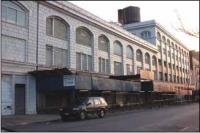 Even if you recycle waste from a building, that doesn't mean the process is environmentally sustainable. That was the message two weeks ago from consultant Donovan Rypkema at the Historic Districts Council conference in New York, and it's relevant in light of Forest City Ratner's press release today announcing the demolition of the Ward Bread Bakery, a building hailed by preservationists.
Even if you recycle waste from a building, that doesn't mean the process is environmentally sustainable. That was the message two weeks ago from consultant Donovan Rypkema at the Historic Districts Council conference in New York, and it's relevant in light of Forest City Ratner's press release today announcing the demolition of the Ward Bread Bakery, a building hailed by preservationists.The press release states:
FOREST CITY RATNER TO BEGIN DEMOLITION OF FORMER WARD BREAD BAKERY
Over 75% of Building to be Recycled as Part of LEED Certification
(Brooklyn, NY) – March 22, 2007 – Forest City Ratner Companies (FCRC), the developer of the Atlantic Yards project in Brooklyn, today announced that abatement and demolition of 800 Pacific Street (also known as the Ward Bread Bakery building) will begin on Monday, March 26, 2007. As part of its sustainability efforts and LEED (Leadership in Energy and Environmental Design) certification process, at least 75% of the demolition debris is expected to be recycled.
“Obtaining LEED certification for Atlantic Yards is one of the highest ‘green’ standards we can achieve,” said Bruce Ratner, President and CEO of FCRC. “Whether it is recycling building materials, using low emission vehicles or reducing storm water overflows into the Gowanus Canal by more than 2 million gallons per year, we are seeking out every possible way to make Atlantic Yards as eco-friendly and environmentally responsible as possible.”
Green buildings not the only answer
Rypkema in New York gave a version of this speech, in which he pointed out that a green building is not necessarily sustainable development:
Far too many advocates in the US far too narrowly define what constitutes sustainable development. Far too many advocates in the US think that so-called green buildings and sustainable development are one in the same. They are not. And I'll come back to that shortly.
Then he got to the issue of "embodied energy":
So much of the "green building" movement focuses on the annual energy use of a building. But the energy embodied in the construction of a building is 15 to 30 times the annual energy use. Razing historic buildings results in a triple hit on scarce resources. First, we throwing away thousands of dollars of embodied energy. Second, we are replacing it with materials vastly more consumptive of energy. What are most historic houses built from? Brick, plaster, concrete and timber. What are among the least energy consumptive of materials? Brick, plaster, concrete and timber. What are major components of new buildings? Plastic, steel, vinyl and aluminum. What are among the most energy consumptive of materials? Plastic, steel, vinyl and aluminum. Third, recurring embodied energy savings increase dramatically as a building life stretches over fifty years. You're a fool or a fraud if you say you are an environmentally conscious builder and yet are throwing away historic buildings, and their components.
Finally, he addressed recycling:
Environmentalists cheer when used tires are incorporated into asphalt shingles and recycled newspapers become part of fiberboard. But when we reuse an historic building, we’re recycling the whole thing. Preservation North Carolina has a bumper sticker that reads, “Historic preservation – the ultimate recycling” and they are absolutely right.
There are costs involved in preserving buildings, and the issue around the Ward Bread Bakery is complex. I'll get to that tomorrow. For now, however, let's recognize the complications behind claims of sustainability.
Great point! It's easy to throw around LEED, Green Building, and recycling but at a more basic level you're just building more and using more resources, even if you're using "sustainable" practices.
ReplyDelete